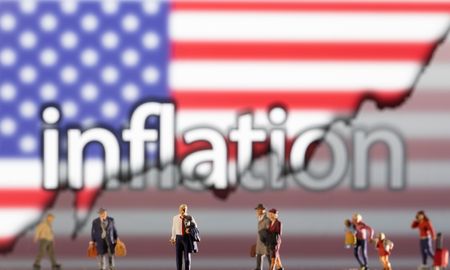
By Lindsay Dunsmuir
(Reuters) -U.S. consumer prices were unchanged in July due to a sharp drop in the cost of gasoline, delivering the first notable sign of relief for weary Americans who have watched inflation climb over the past two years.
The Consumer Price Index (CPI) was flat last month after advancing 1.3% in June, the Labor Department said on Wednesday in a closely watched report that could allow the Federal Reserve to dial down the size of interest rate hikes in September.
The reading was the largest month-on-month deceleration of price increases since 1973 and follows on the heels of a roughly 20% drop in the cost of gasoline. Prices at the pump spiked in the first half of this year due to the war in Ukraine, hitting a record-high average of more than $5 per gallon in mid-June, according to motorist advocacy group AAA.
Economists polled by Reuters had forecast a 0.2% rise in the monthly CPI in July. Aside from its policy meeting next month, the Fed has indicated that several monthly declines in CPI growth would be needed before it lets up on the aggressive monetary policy tightening it has delivered to tame inflation currently running at a four-decade high.
The lower-than-expected CPI data ignited a strong rally in equity markets, with the S&P 500 index rising 1.7% in early trading. Investors immediately slashed bets the Fed will deliver a third straight 75-basis-point rate hike at its Sept. 20-21 meeting, instead seeing the U.S. central bank likely to opt for a half-percentage-point hike.
“This is not yet the meaningful decline in inflation the Fed is looking for. But its a start and we expect to see broader signs of easing price pressures over the next few months,” said Paul Ashworth, chief U.S economist at Capital Economics.
U.S. consumer prices have been surging due to a number of factors, including snarled global supply chains, massive government stimulus early in the COVID-19 pandemic and Russia’s invasion of Ukraine.
Food is one component of the CPI that remained elevated in July, rising 1.1% last month after climbing 1.0% in June.
In the 12 months through July, the CPI increased by a weaker-than-expected 8.5% following a 9.1% rise in June.Underlying inflation pressures, which exclude volatile food and energy components, also showed some green shoots.
The so-called core CPI rose 0.3% in July after climbing 0.7% in June, but still increased 5.9% in the 12 months through July, matching the pace in June.
Inflation in the cost of rent and owners’ equivalent rent of primary residence, which is what a homeowner would receive from renting a home, rose at almost the same pace as in June. Shelter costs comprise about 40% of the core CPI measure.
TIGHT LABOR MARKET
The path of the Fed’s interest rate hikes is of central interest to investors, businesses and consumers as policymakers last week flagged that they will push on with the rate hikes until they see strong and long-lasting evidence that inflation is on track back down to the U.S. central bank’s 2% goal.
An extremely tight labor market also is driving up wages. There may be little relief on that front in light of the stronger-than-expected job growth and wage gains in July. The economy created 528,000 jobs last month and the unemployment rate fell back to its pre-pandemic low, the government reported on Friday.
Labor market tightness is also underscored by the fact that, although U.S. job openings fell to a nine-month low in June, there were still almost two jobs for every unemployed person.
The strength of the job market will make it harder for the Fed to bring the economy into balance soon.
The Fed has hiked its policy rate by 225 basis points since March despite fears that the sharp rise in borrowing costs could tip the economy into recession.
(Reporting by Lindsay Dunsmuir; Editing by Paul Simao)

